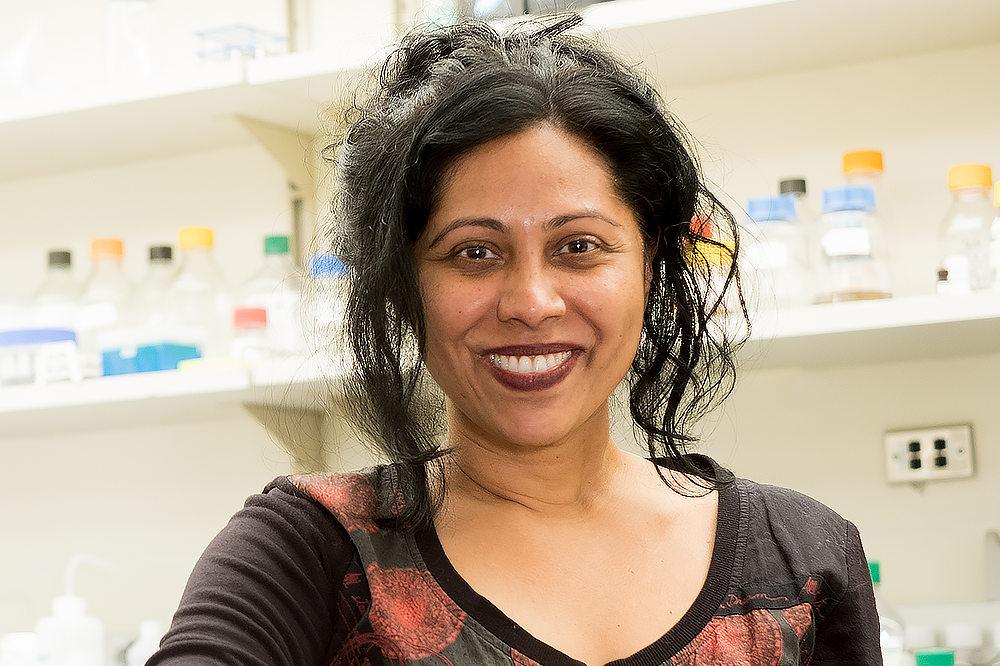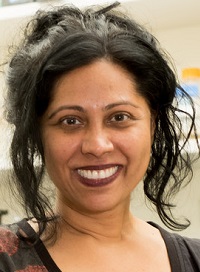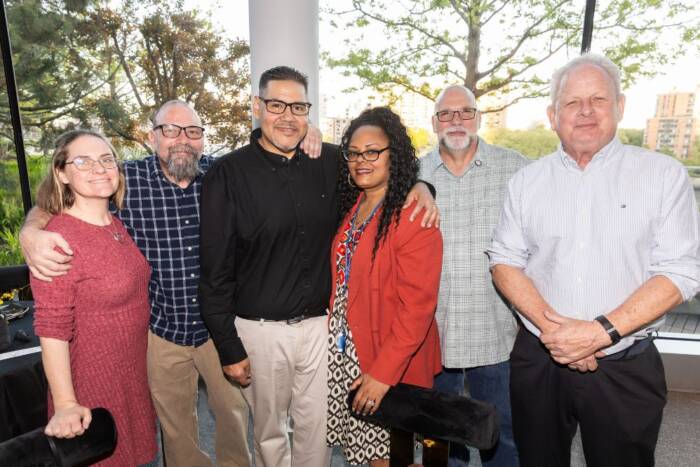Elizabeth Campbell launches Laboratory of Molecular Pathogenesis

(Credit: Mario Morgado)
Most pandemics can be measured in just a few years. But tuberculosis has left its mark on humanity for thousands. We’ve found its DNA fragments in a mother and daughter buried together more than 9000 years ago in the eastern Mediterranean, and have seen the skeletal deformities it caused in people who died during the Bronze Age in Egypt and Sweden. Every era since has had its own name for this scourge: schachepheth, phthisis, scrofula, white plague, consumption.
Despite the vast scientific advances made since Mycobacterium tuberculosis (Mtb) was isolated in 1882, TB remains the world’s leading cause of death from infectious disease. Limited access to healthcare in poor countries and increasing antibiotic resistance to the drugs we developed in the 20th century have only complicated our fight against this ancient foe.
That’s why Rockefeller’s Elizabeth Campbell has spent 12 years studying the mechanisms that make Mtb such a relentlessly effective pathogen. At Rockefeller since 1992, Campbell launches the Laboratory of Molecular Pathogenesis this summer to continue researching TB as well as SARS-CoV-2, the virus behind Covid.
Campbell is well known for her groundbreaking structural and functional insights on the transcriptional mechanisms of Mtb, which have opened new pathways for drug targets. She’s been equally lauded in virology circles for her atomic-level analyses of the virus’s transcription and replication machinery, which were virtually unexplored until her work.
In her new lab, “my main goal is to understand the regulation of gene expression in both pathogens to gain new biological insights and find new processes and targets that can be used for drug development.”
From Georgetown to New York City
Campbell’s family moved to Flushing, Queens, from Georgetown, Guyana, when she was 12 years old to escape the dictatorial regime of Forbes Burnham and provide a better education for her and her sister (who sadly passed away from Covid in 2021). It was at Swarthmore College that she fell in love with microbiology under the tutelage of microbiologist Amy Cheng Vollmer, an expert in bacterial stress response, who asked Campbell to be a teaching assistant in her lab.
Campbell came to Rockefeller for her Ph.D. in 1992, where she worked in the lab of Elaine Tuomanen and Robert Masure studying the regulation of transformation in Streptococcus pneumoniae—a process that helps the bacterium to acquire and incorporate advantageous foreign DNA.
She then joined Seth Darst’s Laboratory of Molecular Biophysics(opens in new window) for her postdoc training, where she studied the structure and biochemistry of bacterial RNA polymerase (RNAP), an enzyme responsible for bacterial transcription, and a common target of antibiotics, which interfere with its functioning. First a research associate and then a research associate professor, Campbell eventually became co-head of the lab with Darst.
As head of her own lab, she’s choosing to revive a name—the Laboratory of Molecular Pathogenesis—previously used by Tuomanen and Masure. “It’s in homage to Elaine and Robert, and also a really appropriate term for what I’m going to do,” she says.
A hallmark of her lab will continue to be collaborative science, an approach that was informed by Darst’s advice. “The thing I value the most from him is his encouragement to be considerate to young researchers—specifically, when in a position to scoop them, to co-publish with them instead,” she says. “This develops their careers rather than upends them.”
A string of discoveries
Among other breakthroughs, Campbell was the first to solve the structure of a mycobacteria RNAP at atomic resolution; discovered the molecular basis of mycobacterial resistance to rifampicin, the most critical component of the cocktails that are used to treat that disease; documented the mechanism of action that explained how an overlooked antibiotic called sorangicin A is effective against antibiotic-resistant Mtb strains; and revealed how wildly different its transcription mechanisms are from those of E. coli, long considered the model organism for bacterial transcription.
This work has led to new drug targets and other strategies for controlling Mtb. But her findings have applications beyond it. For example, after determining how the Mtb RNAP binds to the antibiotic fidaxomicin—a narrow-spectrum antibiotic that has limited bacterial targets—she revealed the molecular mechanism that allows fidaxomicin to kill Clostridium difficile, a gastrointestinal infection that routinely tears through hospitals. The findings might help scientists develop new narrow-spectrum antibiotics against other pathogens.
In the beginning of the Covid pandemic, Campbell thought her bacterial expertise could be applied to the study of SARS-Co-V-2. Cheered on by her colleague, virologist and Nobel laureate Charlie Rice, she and Darst undertook an atomic-level analysis of the RNA-dependent RNA polymerase complexes that drive the replication and transcription of the virus. Little is known about elements of these structures in viruses in general, and virtually nothing was known about them in this novel organism.
They and their teams solved multiple conformational states of these complexes, revealing fundamental characteristics of the virus’s biology for the first time. Their findings led to a bevy of antiviral drug development. For this work, Campbell won the Emil von Behring Prize from Marburg University, becoming only the second woman to receive the honor since the prize began in 1942. (The only other Rockefeller researcher to win was Ralph M. Steinman, in 1996.)
When Campbell’s new lab opens this fall in Smith Hall, she’ll continue to employ the multi-disciplinary approach to TB that has allowed her to capture telling details about its RNA polymerase, including bacteriology, cryo-EM, pathogenesis, biophysics, biochemistry, structural biology, virology, and genetics. The lab space itself was once occupied by the pioneering addiction scientist Mary Jeanne Kreek, who deeply inspired Campbell.
“She was so passionate about making the world a better place,” Campbell says. “She really was my hero at Rockefeller. I still can’t believe I am in such a holy space.”
Paying it forward
Campbell was recently awarded the inaugural Inclusive Excellence Award from Rockefeller’s office of Diversity, Equality, and Inclusion. She has been an advisor to many graduate students and serves on the Tri-Institutional MD-PhD Admissions Committee—and also holds weekly exercise classes on campus that are a modest $5 per class. She donates the class fees to World Central Kitchen and Doctors Without Borders, which operate in high-need crisis environments around the globe.
Her belief that scientific research should better mirror the breadth of humanity took root in Vollmer’s lab at Swarthmore. “She taught me to be very passionate about rigor in research and diversity in science,” Campbell says.
Also inspiring was molecular biologist Carol Gross, whom Campbell first encountered as a newly minted Ph.D. in the late 1990s at a bacteriophage conference. Campbell, who married Darst in 1994 and had given birth to their first daughter, Maya, three weeks prior, was carrying their baby strapped to her chest. At another conference soon after, Campbell was supposed to give a presentation, but the organizers had taken issue with her daughter’s presence. Gross and other attendants—including male colleagues—stepped in to look after Maya during the event. (Maya is now a 26-year-old clinical psychologist whose career trajectory was influenced by her own stint working in Kreek’s lab.)
Later, Campbell, Gross, Darst, and biochemist Robert Landick, one of Campbell’s early mentors, would be instrumental in convincing organizers of other scientific conferences to provide childcare. “We argued that if you want to draw new and young people into the field, you must be open to different life circumstances and backgrounds.”
She adds, “I believe that a diversity of perspectives and experiences truly enhances scientific research. Sometimes people from different socioeconomic and ethnic backgrounds might not have had the same opportunities as others, and they need someone to believe in them or give them a chance. I’ve tried to pay that idea forward. It’s not a political thing. It’s just the moral thing to do—and it greatly benefits science.”



